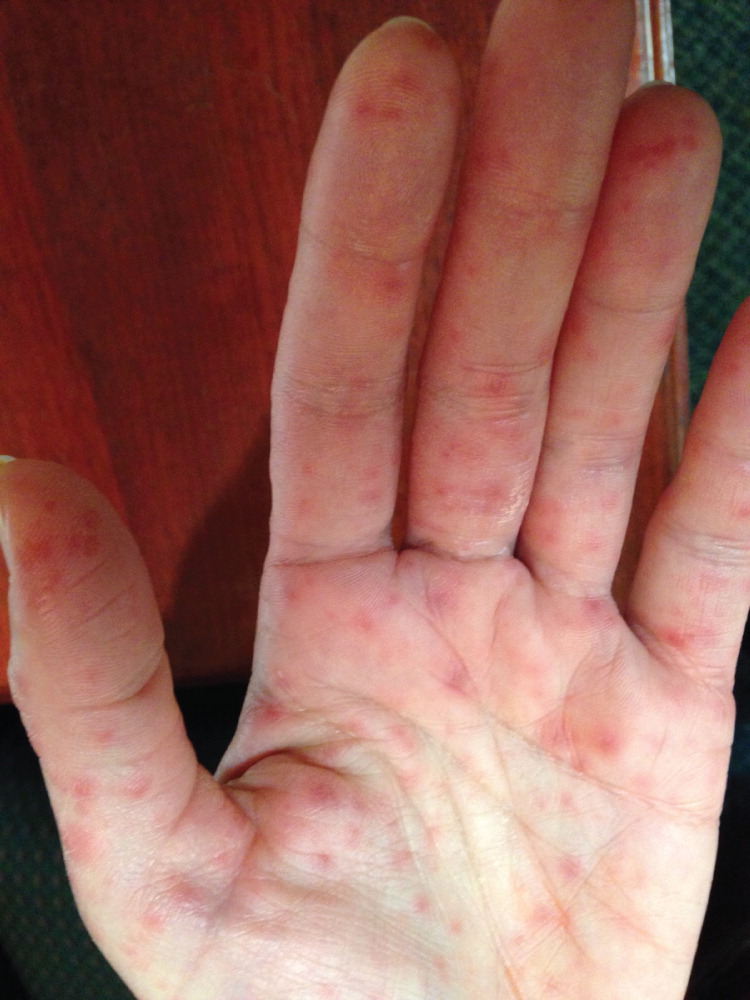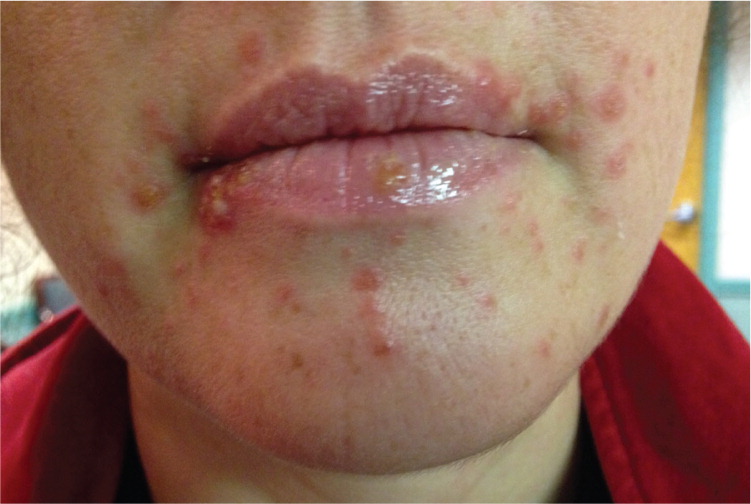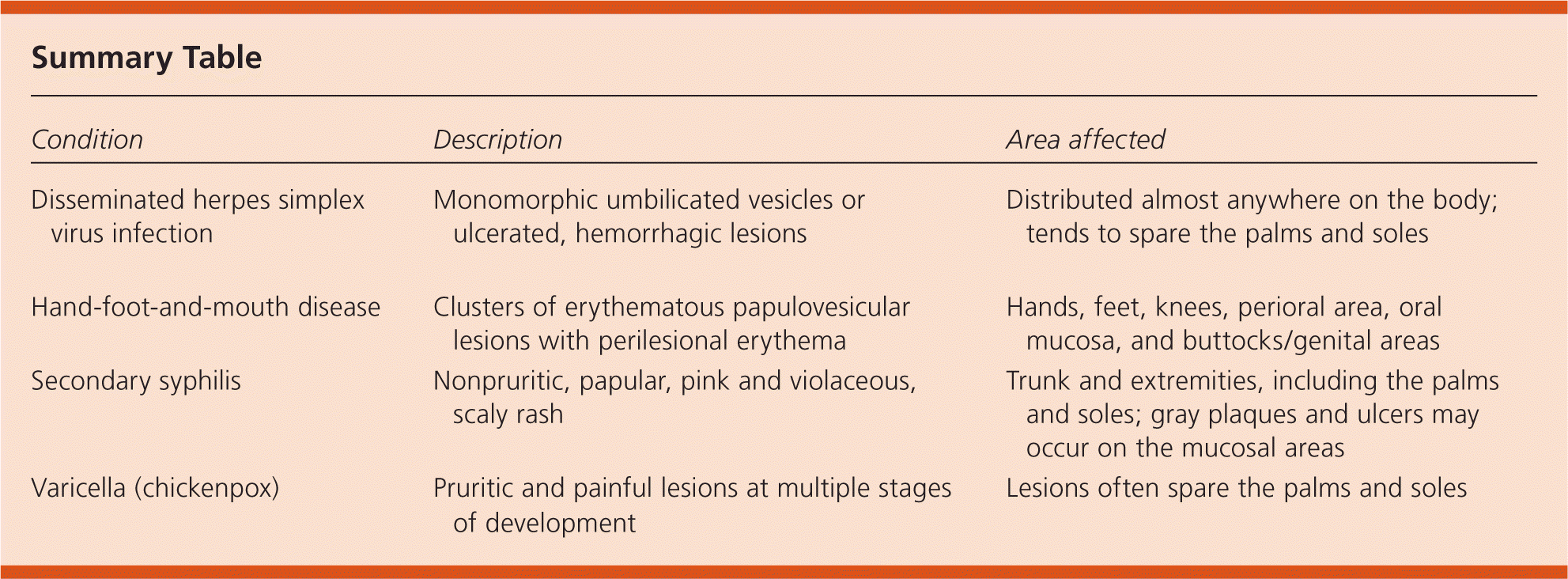
Am Fam Physician. 2015;92(6):525-526
Author disclosure: No relevant financial affiliations.
A 40-year-old woman with no significant medical history presented with a nonpruritic rash that developed rapidly over three days and was progressively worsening. Three days before the rash appeared, she had a fever of 103°F (39.4°C), sore throat, and headache. Diphenhydramine (Benadryl) provided no relief. Ten days before her own symptoms developed, the patient's eight-year-old daughter had a fever, diarrhea, and a similar rash on her feet. The patient had not been exposed to any new medications, foods, or soaps and had not traveled recently.
On physical examination, the patient's temperature was 101°F (38.3°C). She had a diffuse erythematous papulovesicular rash on her distal upper and lower extremities, including her palms and soles (Figure 1). She had a similar rash on her face, predominantly around her lips (Figure 2), and an isolated macule on her soft palate. There was no rash on her trunk. The remainder of her examination was unremarkable.


Question
Discussion
The answer is B: hand-foot-and-mouth disease. This is a clinical syndrome characterized by clusters of erythematous papulovesicular lesions with perilesional erythema. The lesions appear throughout the body but are commonly present on the hands, feet, knees, perioral areas, oral mucosa, and buttocks/genital areas.1,2 Coxsackie-virus A16 and enterovirus A71 are the most common causes.3 The coxsackievirus A6 strain has been associated with worldwide outbreaks and leads to more severe disease.4 Hand-foot-and-mouth disease generally occurs following oral ingestion of the virus shed from the upper respiratory tract or the gastrointestinal system of an infected patient, usually a child.5 The average incubation period is three to 10 days.
Although hand-foot-and-mouth disease is most common in children 10 years and younger, it is becoming more common in adults. Patients often report fever and constitutional symptoms before development of the rash. The diagnosis is clinical, based on the history and the characteristic rash. It is mild and self-limited, with symptoms generally resolving within seven to 10 days. Treatment is supportive and includes fluids, antipyretics, and analgesics. Topical lidocaine and mouthwashes can be used for pain relief if oral ulcers are present. Complications are uncommon but may include fingernail or toenail loss,2 meningitis, encephalitis, myocarditis, and other neurologic sequelae.
Disseminated herpes simplex virus infection may present in individuals with a local herpes infection, and is most common in immunocompromised and pregnant patients. It is characterized by monomorphic umbilicated vesicles or ulcerated, hemorrhagic lesions. Although this rash can appear almost anywhere on the body, the palms and soles are generally spared.
Secondary syphilis occurs with an untreated primary infection. Patients present with a nonpruritic, papular, pink and violaceous, scaly rash on the trunk and extremities, including the palms and soles. Gray plaques and ulcers may occur on the mucosal areas. Systemic symptoms are often present, including fatigue, fever, lymphadenopathy, and gastrointestinal and neurologic abnormalities. Some patients are asymptomatic.
Varicella, or chickenpox, is most common in children. It causes constitutional symptoms and a rash that starts on the face or scalp, then moves toward the extremities. The rash begins as pruritic and painful macules that form fluid-filled vesicles (“dew drops on a rose petal”). Vesicles often appear in the nasopharynx but may also be found in the rectum, conjunctiva, and vagina. Palms and soles are often spared.

| Condition | Description | Area affected |
|---|---|---|
| Disseminated herpes simplex virus infection | Monomorphic umbilicated vesicles or ulcerated, hemorrhagic lesions | Distributed almost anywhere on the body; tends to spare the palms and soles |
| Hand-foot-and-mouth disease | Clusters of erythematous papulovesicular lesions with perilesional erythema | Hands, feet, knees, perioral area, oral mucosa, and buttocks/genital areas |
| Secondary syphilis | Nonpruritic, papular, pink and violaceous, scaly rash | Trunk and extremities, including the palms and soles; gray plaques and ulcers may occur on the mucosal areas |
| Varicella (chickenpox) | Pruritic and painful lesions at multiple stages of development | Lesions often spare the palms and soles |
